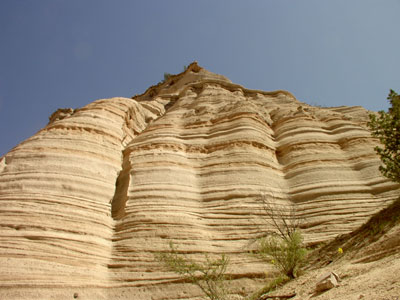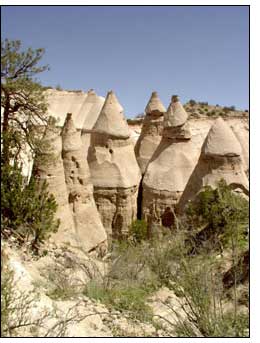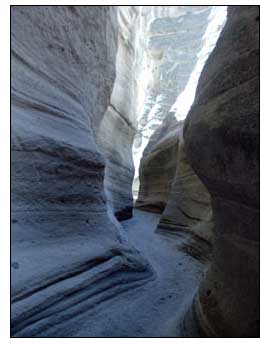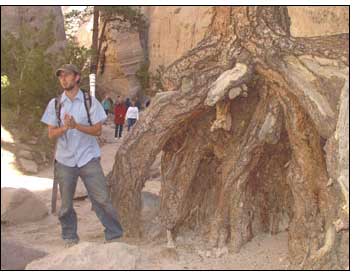 Tent Rocks Rocks!
Tent Rocks Rocks! Anybody who thinks the world is only 5,000 years old should probably spend a day exploring part of the 4,000 acre Kasha-Katuwe Tent Rocks National Monument. Located outside Cochiti Pueblo, about half  way between Albuquerque and Santa Fe, this area speaks volumes about geological history.
way between Albuquerque and Santa Fe, this area speaks volumes about geological history.
I was fortunate to attend a field trip to the area with a group from the University of New Mexico’s Continuing Education. Lead by South African volcanologist Maarten de Moor, we explored the two main trails in the park. Maarten, a congenial young man, recently received his Master of Arts in Volcanology from UNM.
One of the main tenants of geology seems pretty obvious to us these days but was a startling revelation back in the 1800’s: The deeper you dig into the earth, the further back into geological time you go. For example, if you start digging at your local landfill, you will find that the deeper you dig into the layers of garbage, the more ancient will be the newspapers, refrigerators and cars that you find. If you dig deep enough into your own back yard you may be surprised to find the ancient foundation of buildings, pottery, arrowheads and even bones!
Similarly, the earth is like a big landfill. The surface of the earth might be covered with v olcanic ash and debris for a thousand years or so. Then a flood might occur, blanketing the earth with the sort of debris that come with floods. Dinosaurs and plants may decompose into layers and pockets of oil and gas that will make up yet another layer.
olcanic ash and debris for a thousand years or so. Then a flood might occur, blanketing the earth with the sort of debris that come with floods. Dinosaurs and plants may decompose into layers and pockets of oil and gas that will make up yet another layer.
The Tent Rocks area was once volcanic in nature and the earth was covered with layers and layers of white volcanic ash and debris. One curious thing about this area is that a great river once cut through the region like a knife. Well, maybe not so much like a knife as like a shovel. When the waters of this great river resided, the banks of the river revealed the layers of earth that had piled up over millions of years.
Then the winds began to blow. The winds at Tent Rocks are impressive and they create a very smooth surface on the surface of the rock, as if a woodworker had meticulously sanded it.
Now that the waters are gone, we can clearly see the history of the region as told by the layers of sediment that made it. It’s kind of like looking at the rings of a tree, where the center point (or analogously, the lowest point in the earth) marks the trees birth and the bark (the surface of the earth) marks the present day. Every layer of sediment, like every ring of a tree, has a story to tell a trained geologist.
 Nowhere does this little geology lesson become self evident as when you surmount the summit of the slot canyon trail at Tent Rocks National Monument. From the summit, one can see with clarity the history of the region from the beginning of time to the present.
Nowhere does this little geology lesson become self evident as when you surmount the summit of the slot canyon trail at Tent Rocks National Monument. From the summit, one can see with clarity the history of the region from the beginning of time to the present.
Geologists actually have a way of measuring time by calculating the decay of radioactive elements in rocks. These rocks have been dated to be over seven million years old.
Science aside, the region is beautiful just from an aesthetic standpoint. Scientist and creationist can agree that whatever is responsible for this extraordinary sight had the eye of an artist. Beauty is everywhere to be seen. Along a dried river bed we saw millions of ruby red rocks, obsidian, or “Apache Tears,” as they are poetically called. These jewels are actually tiny pieces of molten glass that has been washed down from the ancient, dormant volcanoes and make a great souvenir.
Imagine a boulder sitting upon the earth. The winds slowly but surely erode the area to the sides of the rock but not directly beneath it. Over time a tent formation is created and the boulder remains at its tip, protecting the earth beneath it until, inevitably, the boulder falls over, leaving nothing but the “tent.” If I didn’t see it with my own eyes, I would have a hard time believing that such a thing could happen.
There are two trails at Tent Rocks and by far, the most spectacular one is the “Slot Canyon” trail. From the top of this trail you can see the magnificent stratified cliffs as well as the unworldly tent formations.
“You don’t want to be on this trail when it’s raining,” said Maarten. Signs warn about flash floods that could easily wash a hiker away as well as lightening strikes. Fortunately the day could not have been more perfect. The winds were blowing rather hard but evidently that’s what winds do in these parts. Indeed, were it not for the winds, these tent formations would probably not exist.
Thank you for visiting Chucksville.
|
|


